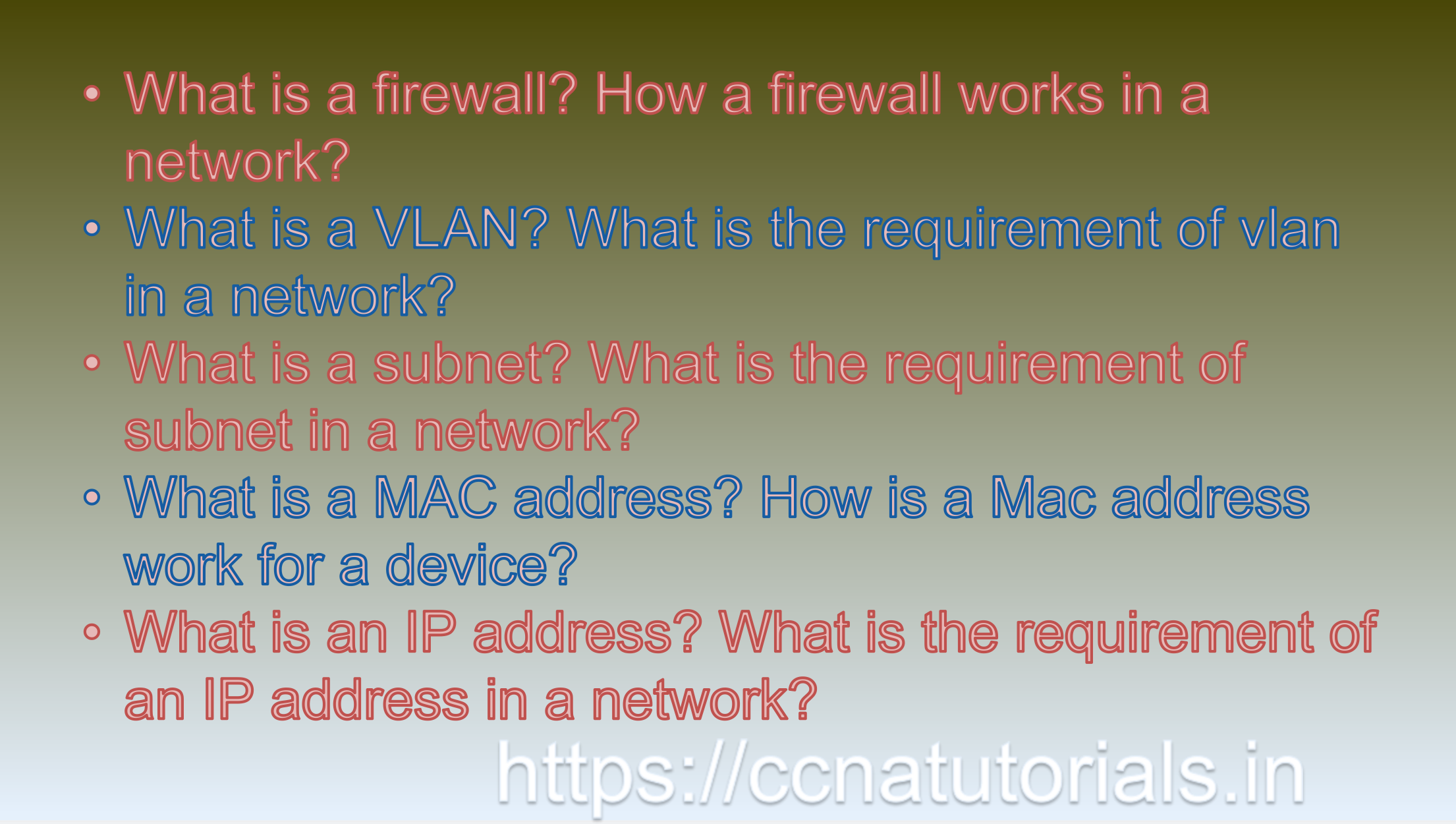Contents of this article
In this article, I describe some CCNA sample questions for practice before appearing in the CCNA 200-301 exam. The following questions are basic questions and related to the CCNA sample questions set 34. There are multiple sample questions set on this website for prior practice online. All questions are described with relevant answers. You can take the following questions and answer as reference for CCNA 200-301 exam. You may also need to do more practice with other websites and books to practice the CCNA sample questions set 34.
Question 1. What is a firewall? How a firewall works in a network?
A firewall is a network security device that monitors and controls incoming and outgoing network traffic based on a set of predetermined rules. The primary function of a firewall is to block unauthorized access while allowing authorized traffic to pass through.
A firewall works by examining each network packet that passes through it and comparing it against a set of rules or policies. If a packet matches a policy, it is allowed to pass through the firewall. If it does not match any policy, the firewall either blocks the packet or sends an alert to the network administrator.
Firewalls can be implemented in both hardware and software, and they can operate at different layers of the network stack. Some firewalls operate at the application layer, while others operate at the network or transport layer.
Firewalls can be configured to block traffic based on a wide range of criteria, including source and destination IP addresses, protocol type, and port number. They can also be configured to perform deep packet inspection, which involves analyzing the content of network packets to detect and block malicious traffic.
Firewalls are a critical component of network security and are commonly used in both home and enterprise environments. They help protect networks from a wide range of threats, including unauthorized access, malware, and denial-of-service attacks. This is the answer to question 1 of CCNA sample questions set 34.
Question 2. What is a VLAN? What is the requirement of vlan in a network?
A VLAN (Virtual Local Area Network) is a logical network segment that enables devices to be grouped together based on criteria such as function, department, or location, regardless of their physical location on the network. VLANs are created by configuring network switches to partition the network into smaller virtual networks.
The primary requirement of VLANs in a network is to provide segmentation and isolation of network traffic. By separating network traffic into different VLANs, administrators can better control and manage network traffic, improve network performance, and enhance network security.
VLANs can also be used to provide more flexibility in network design and to simplify network administration. For example, VLANs can be used to create logical groups of devices that need to communicate with each other, such as servers and clients, or to create separate networks for different departments within an organization.
VLANs can be configured to provide security by segregating traffic from different departments or functions, which can help prevent unauthorized access to sensitive data. VLANs can also be used to optimize network performance by separating network traffic and avoiding network congestion.
Overall, VLANs provide a flexible and scalable solution for network segmentation, which can improve network performance, simplify network management, and enhance network security. This is the answer to question 2 of CCNA sample questions set 34.
Question 3. What is a subnet? What is the requirement of subnet in a network?
A subnet, or subnetwork, is a smaller network segment created by dividing a larger network into smaller, more manageable sections. Subnets are created by using a subnet mask to divide a network into smaller subnetworks based on IP addresses.
The requirement of subnets in a network is to improve network performance, manageability, and security. By dividing a larger network into smaller subnets, network administrators can better control and manage network traffic, improve network performance, and enhance network security.
Subnets allow network administrators to group devices based on criteria such as function, location, or security requirements. By segregating traffic into different subnets, administrators can better control and manage network traffic, reducing the risk of network congestion and improving network performance.
Subnets also provide a means of enhancing network security by limiting the scope of network traffic. By creating separate subnets for different departments or functions within an organization, administrators can prevent unauthorized access to sensitive data and reduce the risk of data breaches.
Subnets also provide a means of conserving IP addresses. By dividing a larger network into smaller subnets, administrators can allocate IP addresses more efficiently, reducing the number of unused IP addresses and conserving address space.
Overall, subnets provide a flexible and scalable solution for network segmentation, which can improve network performance, simplify network management, and enhance network security. This is the answer to question 3 of CCNA sample questions set 34.

Question 4. What is a MAC address? How is a Mac address work for a device?
A MAC address, also known as a Media Access Control address, is a unique identifier assigned to a network interface controller (NIC) for use as a network address in communications within a network segment. A MAC address is a hardware address that is physically embedded in the NIC, and it is typically represented as a series of six pairs of hexadecimal digits separated by colons.
When a device is connected to a network, its NIC is assigned a unique MAC address that is used to identify the device on the network. The MAC address serves as a unique identifier that distinguishes the device from all other devices on the network.
MAC addresses are used at the data link layer of the OSI model and are used by devices to identify each other on a local network. When a device wants to communicate with another device on the same network, it sends a data frame that includes the destination MAC address. The receiving device uses the MAC address to determine if the data frame is intended for it and if so, accepts and processes the data.
In addition to being used for network communication, MAC addresses can also be used for network security purposes. Network administrators can use MAC addresses to implement access control policies that allow or deny access to the network based on the MAC address of the device requesting access.
Overall, MAC addresses are a critical component of network communication and play a key role in identifying and securing devices on a network. This is the answer to question 4 of CCNA sample questions set 34.
Question 5. What is an IP address? What is the requirement of an IP address in a network?
An IP (Internet Protocol) address is a unique identifier assigned to each device connected to a computer network that uses the Internet Protocol for communication. An IP address is a numeric label assigned to a device, usually represented in decimal format, consisting of four numbers separated by periods (e.g. 192.168.0.1).
The primary requirement of an IP address in a network is to enable communication between devices. Each device on a network must have a unique IP address so that data can be sent and received over the network. IP addresses are used to identify devices on a network and allow them to communicate with each other.
IP addresses are also used to identify the source and destination of network traffic. When a device sends data over the network, it includes its IP address as the source address and the IP address of the destination device as the destination address. This enables the network to route the data to the correct destination.
IP addresses can also be used for network security purposes. Network administrators can use IP addresses to implement access control policies that allow or deny access to the network based on the IP address of the device requesting access. IP addresses can also be used to track network activity and monitor network traffic for security threats.
Overall, IP addresses are a critical component of computer networks, enabling devices to communicate with each other and facilitating the transmission of data over the network. Without IP addresses, it would be impossible for devices to communicate over a network. This is the answer to question 5 of CCNA sample questions set 34.
Conclusion for CCNA sample questions set 34
In this article, I described 5 questions with answers related to CCNA 200-301 exam. I hope you found these questions helpful for the practice of the CCNA 200-301 exam. You may drop a comment below or contact us for any queries related to the above questions and answers for CCNA 200-301. Share the above questions If you found them useful. Happy reading!!






